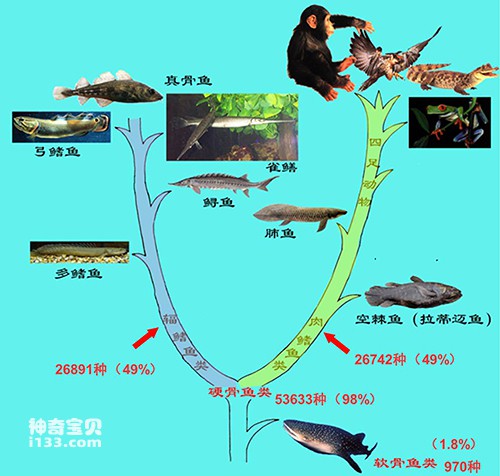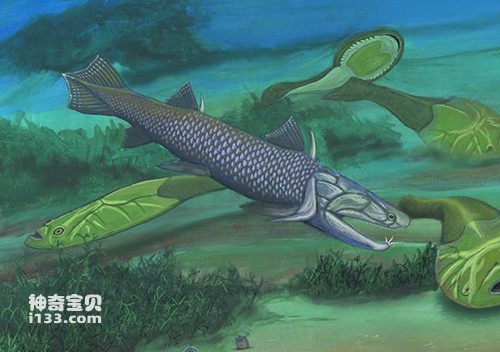The bony fishes are the most prosperous group among living vertebrates and are divided into ray-finned fishes and lobe-finned fishes. According to the classification ideas of modern cladistics, the subclass Sarcopterygii includes not only lungfishes and coelacanths that still live in the water, but also tetrapods that have landed on land. The origin and early differentiation of teleost fishes constitute many key links in the evolutionary chain of vertebrates "from fish to humans". Many anatomical characteristics of us humans can be traced back to the distant ancestors of these fishes, and their ins and outs have always been the focus of paleontology. and a focus issue that the evolutionary biology community is actively exploring.

Teleost fish evolutionary tree
However, until the end of the last century, the fossil data of early teleost fishes was very poor, resulting in a large number of "missing links" in this important position in the evolutionary tree. There are morphological differences between lobe-finned fishes and ray-finned fishes that are difficult to overcome. Learning gap. Research on the origin and early evolution of teleosts has therefore been stagnant for a long time, with few breakthroughs.

Lobe-finned fish
Since 1996, relying on my country's unique Silurian-Devonian vertebrate fossil resources, the research team has continued to carry out field surveys and excavations in Yunnan, Ningxia and other places, and discovered a large number of rare early bony fish fossils. A number of important progresses have been made in the research direction "The Origin and Early Evolution of Teleosts". These works provide insights into resolving some long-debated theoretical issues in the fields of paleontology and evolutionary biology, such as the morphotype of the common ancestor of ray-finned fishes and lobe-finned fishes, the origin of lobe-finned fishes, and the origin of internal nostrils. The key empirical evidence has changed the academic community's inherent understanding of these major issues, strongly promoted the international exploration of the important research direction of the origin and early evolution of teleosts, and has had a greater impact in the world.
Four major discoveries in teleost research
Currently, in the field of research on the origin and early evolution of teleosts, there are about 12 genera that have received the most academic attention and debate, including Backbone Fish, Glossyfish, Dialipina, Powichthys, and Yang's Fish discovered in China. Fish, exotic fish, Kenichthys, Psarolepis, Guiyu, Achoania, Meemannia, Styloichthys, etc. The latter six genera were discovered (4 genera) or re-researched (2 genera) by the project team in the past ten years and published. They have largely changed the traditional understanding of the origin and early evolutionary pattern of teleosts. understanding has driven international research in related fields.
The following four aspects are the most important research progress in this research direction:
(1) The discovery of an unexpected combination of characteristics of the primitive lobe-finned fish Scalyptus provides important clues to unravel the mystery of the origin of teleost fish, making the study of the origin and early evolution of teleost fish a frontier in the field of paleontology today. and one of the hot spots;
(2) The nearly completely preserved Silurian bony fish fossil, the Dream Ghost Fish, was discovered, which provided key information for in-depth exploration of the relationships between major groups of jawed fish, including bony fishes, and deepened the understanding of bony fish. Understanding of the origin and early differentiation of fish;
(3) In-depth research on Ken's fish and Chinese newts has solved the mystery of the origin of the internal nostrils, advanced the fossil record of Asian tetrapods by nearly 100 million years, and expanded the paleogeography of Devonian tetrapods. The distribution area provides important information for exploring the origin of tetrapods;
(4) The discovery of Anaplasma, Mimanus, and Sphenoid Fish has enriched the diversity of Silurian-Devonian bony fishes, especially early lobe-finned fishes, and further supports that southern China is a lobe-finned fish. Hypotheses of origins and early differentiation centers.
The important scientific discoveries in the above four aspects have solved some long-standing theoretical issues in the fields of paleontology and evolutionary biology, such as the morphology of the common ancestor of ray-finned fishes and lobe-finned fishes, the origin of lobe-finned fishes, and the internal nostrils. The origin of fishes, etc., provided key evidence, changed the academic community's inherent understanding of these major issues, and strongly promoted the international exploration of the important research direction of the origin and early evolution of teleost fishes, creating a new generation in the world. had a greater impact.
In this regard, Dr. Friedman of the University of Oxford commented, "The fossil fishes in eastern Yunnan, China have greatly enriched our understanding of the diversity and interrelationships of early bony fishes, breaking the stability of traditional taxonomic groups in the second half of the 20th century, triggering This initiated a new round of systematic research on early lobe-finned fishes that continues to this day." These new discoveries are of great significance for clarifying the evolutionary direction of some important characteristics in the early evolution of bony fishes, especially lobe-finned fishes. They also greatly enriched the diversity of early lobe-finned fishes and further supported the idea that southern China was a carnivorous fish. Hypothesis for the center of origin of ray-finned fishes.
animal tags:
We created this article in conjunction with AI technology, then made sure it was fact-checked and edited by a Animals Top editor.